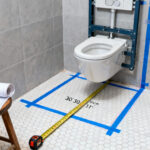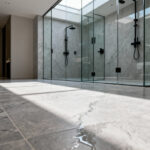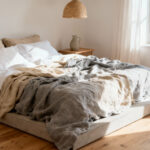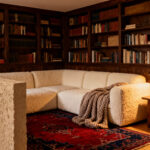Tucked between the vanity and the shower, your bathroom harbors a secret weapon for organization that most homeowners completely overlook. While you’re wrestling with cluttered countertops and overflowing medicine cabinets, prime real estate sits unused just inches above your toilet tank. This vertical frontier represents one of the most underutilized spaces in modern homes, yet it holds the key to transforming cramped, chaotic bathrooms into serene, functional sanctuaries.
The right bathroom shelve over toilet doesn’t just add storage—it fundamentally changes how your space feels and functions. Picture walking into a bathroom where every essential has its designated place, where decorative touches create ambiance without consuming precious counter space, and where the room itself feels larger and more intentional. This transformation isn’t reserved for spacious master suites or expensive renovations; it’s achievable in any bathroom with the right approach.
These 18 essential tips will guide you through every aspect of selecting, installing, and styling the perfect over-toilet storage solution. From measuring techniques that prevent costly mistakes to material choices that withstand bathroom humidity, we’ll explore practical strategies that work in real homes. Whether you’re a renter seeking damage-free solutions or a homeowner ready to maximize every square inch, these insights will help you unlock your bathroom’s hidden potential.
1. Define Your Primary Purpose: Storage, Display, or Both
Before browsing designs or measuring spaces, the most critical decision involves determining whether your bathroom shelve over toilet will serve primarily for storage, display, or a strategic combination of both. This foundational choice influences every subsequent decision, from material selection to shelf depth, and ultimately determines whether your investment reduces clutter or inadvertently creates more visual chaos.
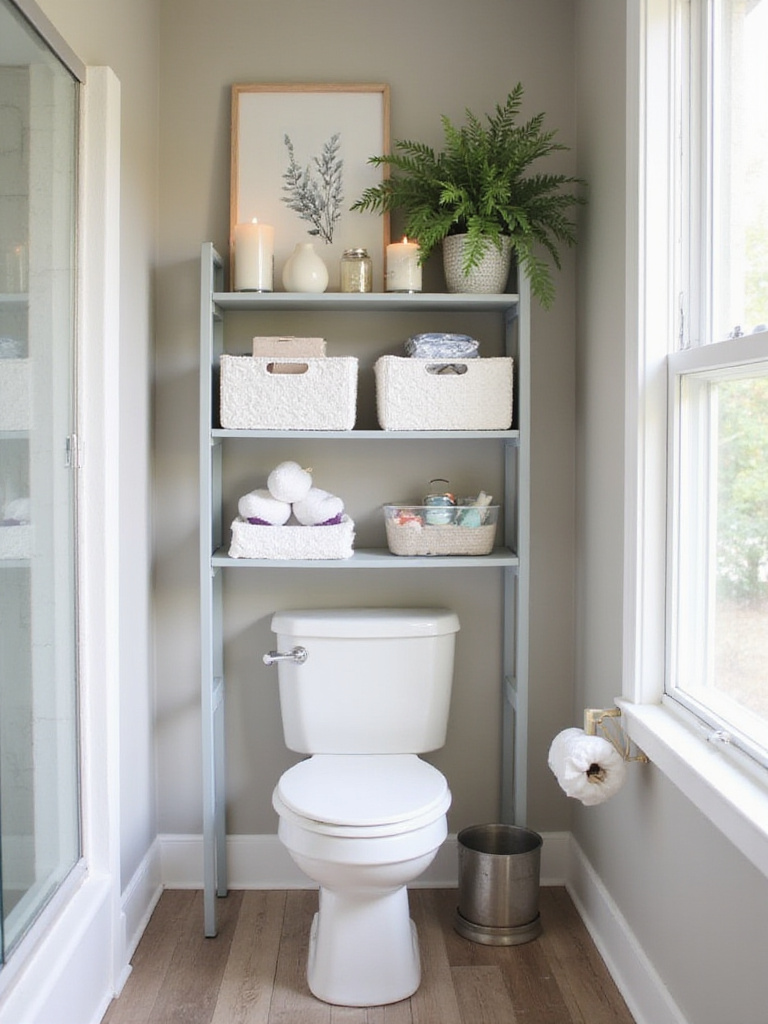
Professional organizers consistently emphasize that unclear purpose leads to cluttered, ineffective storage solutions. When you haven’t defined specific goals, shelves become catch-alls for random items, defeating their organizational purpose. A storage-focused shelf might feature enclosed cabinets and deep compartments for toiletries and linens, while a display-oriented approach calls for open shelving that showcases decorative elements and creates visual interest. The hybrid approach—perhaps 70% storage with 30% display—offers practical functionality while maintaining aesthetic appeal.
The magic of this collection lies in its intentional curation—each piece speaks to your bathroom’s specific needs and your family’s daily rhythms.
2. Master Accurate Measurements for Perfect Placement
Precise measurement prevents the frustration of ill-fitting shelves and protects your walls from unnecessary damage. The golden rule of “measure twice, drill once” becomes especially crucial in bathrooms, where space constraints and fixture placement create unique challenges that standard measurements can’t address.
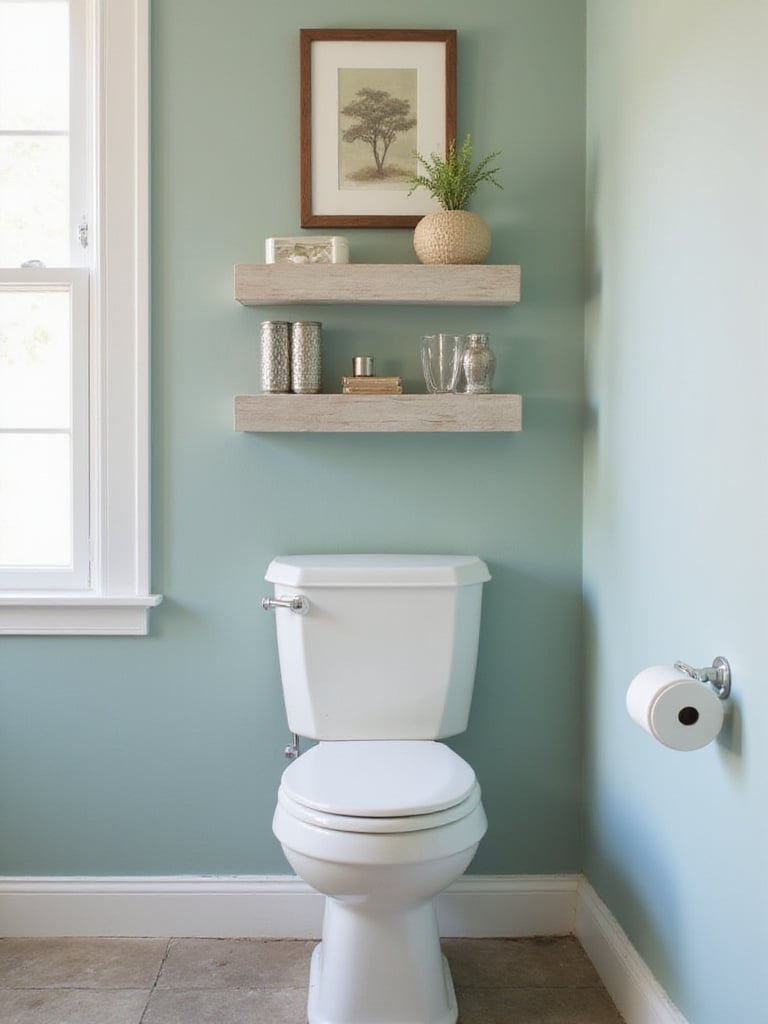
Start by determining optimal height clearance—sit on the toilet to ensure comfortable head space, typically requiring 24-30 inches above the bowl rim. Measure the exact width between walls, fixtures, or obstacles, then subtract half an inch for installation clearance. Don’t forget to check depth requirements; most over-toilet spaces accommodate 6-8 inches without impeding movement or door swing. Use a stud finder to locate mounting points, as proper anchoring determines your shelf’s long-term stability and weight capacity.
- Height: 20-24 inches above tank lid for bottom shelf
- Width: Actual space minus 0.5 inches for clearance
- Depth: 6-8 inches maximum for comfortable movement
- Stud location: Mark precise centers for secure mounting
Look closely and you’ll notice the subtle difference between rushed measurements and careful planning—one leads to perfectly integrated storage, while the other creates ongoing frustration.
3. Verify Weight Capacity for Safe, Reliable Storage
Understanding weight limits involves more than reading manufacturer specifications—it requires calculating the combined capacity of your shelf material, mounting hardware, and wall structure. This comprehensive approach prevents dangerous failures and protects both your bathroom fixtures and family safety.

Bathroom items accumulate weight quickly: a gallon of liquid weighs approximately 8.3 pounds, while a stack of five bath towels adds 6-10 pounds to your shelf’s load. Many homeowners underestimate these cumulative weights, leading to sagging shelves or catastrophic failures. Professional installers recommend mounting into wall studs whenever possible, as this provides 80-100+ pounds of shear strength per screw compared to 5-10 pounds for basic plastic anchors.
Calculate your intended load by weighing actual items with a kitchen scale, then ensure your total stays well below the lowest-rated component in your mounting system. Remember that weight distribution matters—heavier items should sit closer to mounting points rather than at unsupported shelf edges.
What makes this approach better for our homes is the peace of mind that comes from engineered safety rather than hopeful guesswork.
4. Match Shelf Type to Your Bathroom’s Unique Layout
Your bathroom’s dimensions and traffic patterns dictate which shelf style will enhance rather than hinder daily routines. A narrow galley bathroom calls for different solutions than a spacious master suite, and understanding these spatial relationships ensures your bathroom shelve over toilet integrates seamlessly into existing workflows.
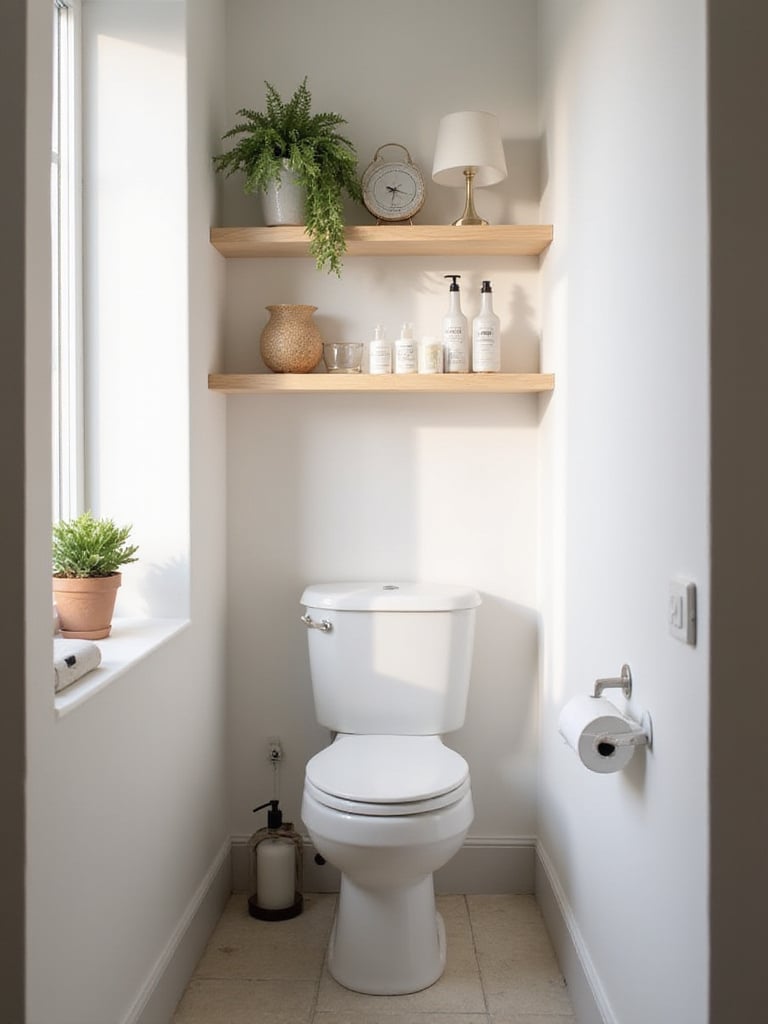
floating shelves work beautifully in minimalist spaces where visual lightness matters, while cabinet-style units provide maximum storage in family bathrooms where concealment trumps aesthetics. Ladder-style units offer graduated storage that doesn’t overwhelm compact spaces, and their open structure allows light to flow through, maintaining an airy feel. Consider your bathroom’s existing style—modern spaces benefit from clean lines and hidden storage, while traditional designs can accommodate more decorative, furniture-like pieces.
Traffic flow analysis reveals optimal shelf placement: high-traffic bathrooms need easily accessible storage, while guest bathrooms can prioritize visual appeal over daily functionality. Measure not just the space but also how people move through it, ensuring your shelf enhances rather than impedes natural movement patterns.
- Narrow spaces: Slim ladder units or single floating shelves
- Family bathrooms: Cabinet-style units with enclosed storage
- Guest bathrooms: Decorative open shelving for visual appeal
- Modern designs: Clean-lined floating shelves or recessed units
The artisan’s journey behind this decision-making process begins with understanding your space’s unique personality and daily demands.
5. Choose Between Open Shelves and Concealed Storage
This fundamental design choice shapes both your bathroom’s aesthetic and its functional efficiency. Open shelving creates visual lightness and immediate accessibility, while concealed storage offers clutter-free serenity and discrete organization for less attractive necessities.

Open shelves demand curatorial discipline—every visible item becomes part of your bathroom’s design story. They work beautifully when you’re committed to maintaining organized, attractive displays of rolled towels, elegant containers, and carefully chosen decorative elements. However, they require ongoing attention to prevent visual clutter and frequent dusting in humid environments.
Concealed storage excels at hiding the practical realities of bathroom life: bulk toiletries, cleaning supplies, medications, and personal items that serve important functions without contributing to aesthetic goals. Modern cabinet designs can be virtually invisible, creating clean lines while providing substantial storage capacity.
The environmental story behind this choice involves understanding your maintenance commitment and aesthetic priorities—open shelving rewards consistent curation, while concealed storage forgives everyday chaos.
6. Select Water-Resistant Materials for Lasting Durability
Bathroom humidity levels fluctuate between 60-90% during daily use, creating an environment that can destroy unsuitable materials within months. Choosing water-resistant options for your bathroom shelve over toilet ensures years of reliable service and maintains both structural integrity and visual appeal.

Standard particle board or MDF can absorb up to 25% of their weight in moisture, leading to swelling, warping, and delamination. Marine-grade plywood, PVC foam board, tempered glass, and properly sealed hardwoods like teak or bamboo resist moisture penetration and maintain their appearance over time. Even naturally water-resistant materials benefit from appropriate sealers—marine-grade polyurethane or specialized bathroom finishes provide additional protection.
Consider your bathroom’s ventilation when selecting materials. Poorly ventilated spaces require maximum moisture resistance, while well-ventilated bathrooms can accommodate a broader range of materials with proper sealing. Stainless steel and powder-coated metals offer excellent durability, while certain engineered composites combine moisture resistance with attractive wood-like appearances.
- Highest resistance: Marine-grade plywood, PVC foam board, tempered glass
- Natural options: Teak, bamboo, cedar with marine-grade finish
- Metal choices: Stainless steel, powder-coated aluminum
- Engineered alternatives: WPC (Wood Plastic Composite) materials
The sustainable journey of selecting appropriate materials involves balancing immediate cost with long-term performance and replacement frequency.
7. Decide Between DIY Assembly and Pre-Assembled Units
This choice significantly impacts your project timeline, required skills, and final results. Pre-assembled units offer convenience and guaranteed quality, while DIY projects provide customization opportunities and potential cost savings at the expense of time and complexity.

Pre-assembled bathroom shelve over toilet units typically install within 30-60 minutes using basic tools, with all hardware included and instructions tested through multiple installations. They eliminate measurement errors, joinery challenges, and finish application, making them ideal for renters or homeowners prioritizing speed and reliability over customization.
DIY projects can save 30-50% on material costs while allowing perfect customization for unusual spaces or specific aesthetic requirements. However, they require tools, skills, and time that many homeowners underestimate. Factor in potential material waste, learning curves, and the possibility of starting over if initial attempts fail.
The craftsmanship reveals itself in details like precise measurements, proper joinery, and professional-quality finishes that distinguish successful DIY projects from amateur attempts.
8. Prioritize Adjustable Shelves for Maximum Flexibility
Fixed shelf heights create permanent limitations that may not accommodate changing storage needs or varying product sizes. Adjustable shelving systems maximize your bathroom shelve over toilet’s versatility and ensure optimal space utilization regardless of what you need to store.

Bathroom products vary dramatically in height—from compact travel containers to family-sized shampoo bottles—and adjustable shelves accommodate this range efficiently. They also adapt to evolving needs: what starts as towel storage might later become toiletry organization or decorative display space. Quality adjustable systems use multiple mounting holes or track systems that maintain stability while offering flexibility.
Measure your tallest and shortest bathroom items before purchasing to understand the adjustment range you need. Look for systems with easy-to-use adjustment mechanisms that don’t require tools for reconfiguration. Some units offer removable shelves that can be repositioned or removed entirely for cleaning or storage of larger items.
The evolution of this trend reflects broader cultural shifts toward adaptable, multi-functional home solutions that grow with changing lifestyles.
9. Integrate Towel Bars and Hooks for Complete Organization
Combining towel storage with your bathroom shelve over toilet maximizes vertical space efficiency and creates a comprehensive organization system. This integrated approach ensures towels dry properly while remaining easily accessible and visually organized.

Strategic placement of towel bars or hooks on shelf sides or adjacent wall space creates dedicated drying areas that promote air circulation and prevent mildew. Consider the weight and size of different towel types—hand towels work well on hooks, while bath towels need longer bars for proper hanging. Ensure adequate clearance so hanging towels don’t interfere with toilet use or shelf access.
Quality hardware matters in humid environments. Choose rust-resistant materials like stainless steel or brass, and ensure mounting points can support wet towel weight. Adhesive solutions work for hand towels in rental situations, while permanent installations can accommodate heavier bath towels.
- Hand towels: Individual hooks on shelf sides
- Bath towels: Longer bars mounted on adjacent walls
- Washcloths: Small hooks or clips on shelf edges
- Guest towels: Decorative hooks that complement shelf design
Beyond the obvious placement, consider using integrated towel storage to create visual balance and functional zones within your bathroom space.
10. Enhance Ambiance with Integrated Lighting Solutions
Thoughtfully placed lighting transforms your bathroom shelve over toilet from simple storage into an atmospheric focal point. Integrated lighting provides practical illumination while creating the layered lighting essential for well-designed bathrooms.

LED strip lights mounted under shelves create gentle ambient lighting that reduces harsh overhead glare during nighttime visits. Puck lights can highlight decorative elements or provide task lighting for grooming activities. Battery-powered options offer installation flexibility, while hardwired solutions provide permanent, switch-controlled lighting that integrates with existing electrical systems.
Consider color temperature carefully—warm white (2700K-3000K) creates relaxing ambiance, while cool white (4000K+) provides task-oriented illumination. Dimmable options offer maximum flexibility, allowing you to adjust brightness for different times of day or activities. Motion sensors add convenience for nighttime use without disturbing sleep patterns.
The interplay between the lighting and your shelf’s contents creates dramatic shadows and highlights that add depth and visual interest to your bathroom space.
11. Maximize Small Bathroom Potential with Vertical Storage
Compact bathrooms benefit enormously from vertical storage strategies that utilize every available inch without consuming precious floor space. Your bathroom shelve over toilet can increase storage capacity by 200-300% compared to horizontal solutions alone.

Vertical storage draws the eye upward, creating an illusion of height and spaciousness in cramped quarters. Multi-tier units provide graduated storage that accommodates different item sizes while maintaining visual balance. Consider tapering designs that start wider at the bottom and narrow toward the top, preventing the overwhelming appearance that can make small spaces feel claustrophobic.
Layer storage solutions by combining your over-toilet shelf with wall-mounted organizers, door-mounted racks, and under-sink storage to create a comprehensive system. Each vertical zone should serve specific functions—frequently used items at eye level, backup supplies higher up, and decorative elements where they create the most visual impact.
When clients ask us about maximizing small bathrooms, we always emphasize that vertical storage isn’t just about adding shelves—it’s about creating organized systems that make every item easily accessible.
12. Explore No-Drill Options for Rental-Friendly Solutions
Renters and homeowners hesitant about wall damage can achieve excellent over-toilet storage without permanent modifications. No-drill solutions preserve security deposits while providing functional organization that rivals traditional mounted systems.
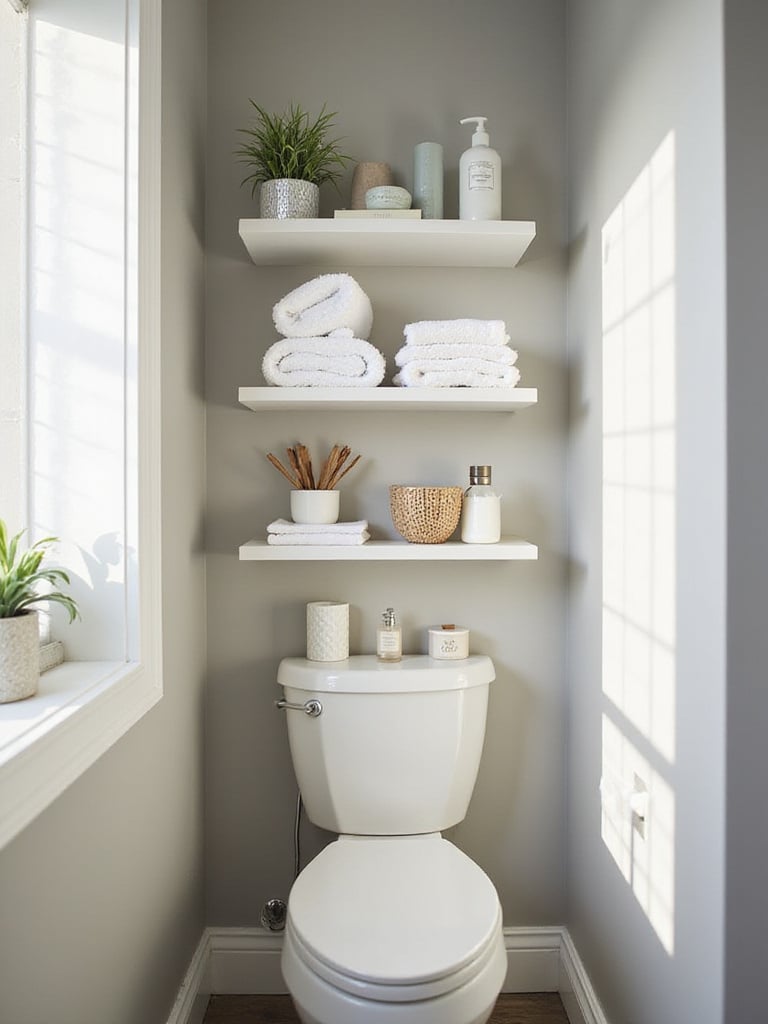
Tension-based systems use spring-loaded mechanisms to secure shelving units between floor and ceiling, requiring no wall attachment while supporting substantial weight. Freestanding over-toilet units straddle the toilet tank, providing multiple storage tiers without any wall contact. High-quality suction cup systems work well on smooth tile surfaces for lighter storage needs.
Adhesive solutions have evolved significantly, with heavy-duty strips capable of supporting 10-15 pounds when properly applied to clean, smooth surfaces. These work particularly well for temporary installations or lightweight decorative shelving. Always test adhesive strength with light items before trusting them with valuable or breakable objects.
- Tension systems: Floor-to-ceiling units with spring mechanisms
- Freestanding units: Over-toilet cabinets that require no mounting
- Suction solutions: Heavy-duty cups for smooth tile surfaces
- Adhesive strips: Damage-free mounting for lightweight applications
The unexpected environmental benefit comes from the reusability of these systems, which can move with you and adapt to different bathroom configurations.
13. Organize Toiletries Strategically for Daily Efficiency
Smart toiletry organization transforms your bathroom shelve over toilet from storage space into an efficiency system that streamlines daily routines. Strategic placement and categorization reduce search time while maintaining visual appeal.

Group similar items together—dental care, skincare, hair products—and place frequently used items at eye level for immediate access. Use clear containers to maintain visibility while containing smaller items that might otherwise scatter. Implement a “front-to-back” system where current products sit in front with backups behind them, ensuring nothing expires forgotten.
Vertical organization within shelf space maximizes capacity. Tiered organizers and small risers create multiple levels within single shelves, accommodating various bottle heights while maintaining accessibility. Consider the weight distribution of liquid products, placing heavier items toward shelf supports rather than at unsupported edges.
Label containers for shared bathrooms or less obvious contents, but choose elegant labeling that enhances rather than detracts from your bathroom’s aesthetic. Consistent container styles create visual cohesion even when storing diverse products.
The styling mistake most people make is treating organization as purely functional rather than considering how organized systems contribute to bathroom ambiance and daily satisfaction.
14. Elevate Visual Appeal with Curated Decor and Plants
Your bathroom shelve over toilet offers prime real estate for creating visual interest and introducing natural elements that enhance the space’s overall ambiance. Strategic styling transforms utilitarian storage into an attractive focal point that elevates your entire bathroom design.

Select humidity-loving plants like snake plants, ZZ plants, or pothos that thrive in bathroom conditions while improving air quality. Use attractive, non-porous containers that complement your bathroom’s color scheme and style. Balance living elements with carefully chosen decorative objects—perhaps a small sculptural piece, elegant candle, or stack of beautifully folded towels.
Apply the “rule of three” when arranging items, grouping objects in odd numbers while varying heights and textures for visual interest. Consider the sight lines from different bathroom positions—what looks good from the vanity might need adjustment when viewed from the shower or doorway.
Functional decor serves double duty: attractive storage containers, decorative soap dispensers, or elegant towel arrangements provide both utility and visual appeal. This approach maximizes the impact of every item while maintaining the organized efficiency that makes your bathroom shelve over toilet truly functional.
The composition comes together when you balance practical storage needs with aesthetic goals, creating a space that feels both organized and intentionally designed.
15. Prevent Clutter Through Consistent Maintenance Habits
Maintaining an organized bathroom shelve over toilet requires establishing simple, sustainable habits that prevent the gradual accumulation of unnecessary items. Proactive maintenance is far more effective than periodic major cleanouts.

Implement a “one in, one out” policy for toiletries—when you bring home a new shampoo bottle, remove the empty or nearly empty one. This simple rule prevents the multiplication of half-used products that create visual clutter and waste storage space. Schedule weekly five-minute “shelf sweeps” during regular bathroom cleaning to remove empties, return misplaced items, and maintain organization.
Assign specific “homes” for different item categories and train family members to return items to their designated spots immediately after use. This prevents the gradual migration of items that leads to cluttered, disorganized shelves over time.
- Daily habit: Return items to designated spots after use
- Weekly routine: Remove empties and return misplaced items
- Monthly review: Assess what’s working and adjust organization as needed
- Seasonal purge: Remove expired products and unused items
The challenge of maintaining organization becomes easier when you view it as preserving a system that makes your daily routine more efficient rather than just keeping things tidy.
16. Ensure Secure Installation for Long-Term Reliability
Proper installation determines whether your bathroom shelve over toilet remains a reliable storage solution or becomes a safety hazard. Secure mounting protects both your bathroom fixtures and family members while maximizing the shelf’s weight capacity and longevity.

Locate wall studs whenever possible, as mounting into structural supports provides 80-100+ pounds of shear strength per screw compared to 5-10 pounds for basic drywall anchors. Use a quality stud finder and mark stud centers precisely before drilling. For installations requiring drywall anchors, choose heavy-duty toggle bolts or molly bolts rated for your shelf’s intended load.
Pre-drill pilot holes slightly smaller than your screw diameter to prevent splitting or cracking. Ensure screws penetrate studs by at least 1.5 inches for maximum holding power. Use a level to ensure perfect alignment—crooked shelves not only look unprofessional but may also create uneven weight distribution that compromises stability.
Consider using a mounting board (ledger board) for very heavy installations. This distributes weight across multiple studs and provides a continuous mounting surface that can support substantial loads while simplifying installation alignment.
The construction technique that ensures longevity involves over-engineering your mounting system rather than accepting minimum requirements that may fail under real-world conditions.
17. Maintain Cleanliness with Simple Care Routines
Regular maintenance preserves both the appearance and functionality of your bathroom shelve over toilet while preventing the buildup of moisture, dust, and potential mildew that can compromise materials and hygiene.

Establish a daily quick-wipe routine using a dry microfiber cloth to remove water spots and dust—this 30-second habit prevents accumulation that becomes difficult to remove later. Weekly cleaning should involve removing all items and thoroughly cleaning the shelf surface with appropriate cleaners for your specific materials. Wood requires pH-neutral cleaners, while glass and metal can handle stronger solutions.
Monthly deep cleaning includes inspecting mounting hardware for looseness, checking for any signs of moisture damage, and cleaning both the shelf and stored items. This regular inspection catches potential problems before they become serious issues requiring major repairs or replacement.
Choose cleaning products specifically formulated for bathroom use and your shelf materials. Avoid abrasive cleaners that can damage finishes, and always dry surfaces completely to prevent water damage or mineral deposits.
The quality becomes evident after years of use when properly maintained shelves show minimal wear while neglected ones require premature replacement or refinishing.
18. Discover Effective Solutions Under $50
Budget-conscious homeowners can achieve excellent over-toilet storage without compromising functionality or style. Smart shopping and strategic choices make quality bathroom shelve over toilet solutions accessible regardless of financial constraints.

Major retailers consistently offer well-designed units in the $25-45 range that provide years of reliable service. Look for sales at Target, Walmart, and IKEA, where basic but functional units often drop below $30. Online marketplaces offer even more options, though shipping costs may affect total pricing. Consider end-of-season clearances and floor model sales for higher-quality units at reduced prices.
DIY approaches can create custom solutions for under $30 using basic materials from hardware stores. Simple floating shelves made from pine boards and L-brackets cost $15-25 in materials while offering perfect size customization. Upcycling projects using crates, old drawers, or reclaimed wood can create unique pieces for even less.
Enhance budget units with attractive baskets, bins, or shelf liners that add style and functionality. A $35 basic shelf can look like a $100 unit with the addition of coordinated storage containers and thoughtful styling.
- Retail options: Target, Walmart, IKEA units typically $25-45
- DIY materials: Pine boards and brackets under $30
- Upcycling projects: Crates and reclaimed materials under $20
- Enhancement accessories: Baskets and liners $10-20
The investment value comes from choosing solutions that meet your specific needs rather than the most expensive options that may offer unnecessary features.
Transform Your Bathroom Today
The space above your toilet represents one of the most underutilized opportunities in modern bathroom design. Through these 18 essential strategies, you now have the knowledge to transform this overlooked area into a functional, beautiful storage solution that enhances your daily routine while maximizing your bathroom’s potential.
Whether you choose a simple floating shelf for minimalist appeal, a comprehensive cabinet system for maximum storage, or a budget-friendly DIY solution that reflects your personal style, the key lies in thoughtful planning and execution. Remember that the best bathroom shelve over toilet is one that serves your specific needs while complementing your space’s unique characteristics and constraints.
Your bathroom transformation begins with a single decision to reclaim that wasted vertical space. Start by defining your primary purpose, take accurate measurements, and choose solutions that align with your lifestyle, budget, and aesthetic preferences. The result will be a more organized, efficient, and visually appealing bathroom that proves good design doesn’t require extensive renovations—just smart use of available space.

